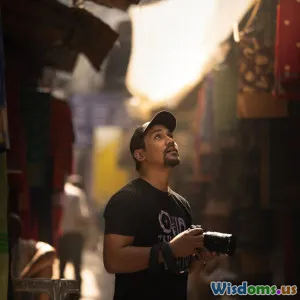
Exploring the Global Art Market Today
7 min read A deep dive into the trends, challenges, and dynamics shaping today's global art market. (0 Reviews)
Exploring the Global Art Market Today
The art world has long fascinated enthusiasts, collectors, and investors alike, but the global art market in 2024 stands as a complex, evolving ecosystem far beyond traditional auction halls. Exploring this market today reveals a tapestry woven with cultural shifts, technological disruption, and economic variability.
Why should anyone matter about the art market? Because it is not just a niche realm for the wealthy, but a prism reflecting societal values, financial trends, and the power of creativity as a global language. As we unpack this dynamic cultural economy, prepare to understand not only how art is bought and sold but also how it shapes and is shaped by society at large.
The Resilience and Growth of the Global Art Market
Despite global economic uncertainties influenced by inflation, geopolitical tensions, and pandemic after-effects, the global art market has demonstrated resilience and growth. In 2023, the art market's overall value surged past $70 billion according to Art Basel and UBS’s annual report, setting new records especially in the contemporary art segment.
Auction Houses as Market Barometers
Iconic auction houses like Sotheby's and Christie's continue to dominate landmark deals but have adapted by offering innovative digital services and hybrid auction models. For example, Sotheby’s recorded a $416 million digital art auction in April 2024, a sign of shifting buyer behavior toward non-tangible assets like NFTs (Non-Fungible Tokens).
Expanding Collector Base
Emerging markets, notably in Asia and the Middle East, present vibrant forces in today's art economy. Chinese collectors constitute an increasing share of high-end art purchases, fueled by burgeoning wealth and growing domestic cultural pride. Hong Kong has positioned itself as a critical auction powerhouse, tying Eastern demand with Western supply channels.
Digital Revolution: NFT Art and Beyond
One of the most transformative developments reshaping the art market is the rise of digital art forms, especially NFTs. In the earlier 2020s, NFTs dramatically redefined concepts of ownership, provenance, and accessibility.
NFTs Empowering Artists & Collectors
NFTs have democratized access for artists, enabling creators to reach global audiences without traditional gatekeepers like galleries or auction houses. It also facilitates royalties on secondary sales, a breakthrough for fair artist compensation.
Nevertheless, this innovation brings volatility. The NFT market faced sharp corrections after exuberant hype, underscoring the need for sustainable infrastructure and regulation.
Blockchain Enhancing Transparency
Beyond NFTs, blockchain technology strengthens the art market by improving transparency around artwork provenance and authenticity. This can reduce fraud, a perennial challenge for buyers and sellers alike.
The Cultural Impact and Ethical Dimensions
The art market reflects not only economic transactions but profound cultural dialogues. Discussions about provenance, restitution of looted artifacts, and representation within the market have gained momentum.
Restitution and Decolonization Movements
Institutions worldwide are confronted with calls to return artworks appropriated during colonial eras, reshaping how museums and collectors handle ethics. The recent return of Benin Bronzes to Nigeria, for example, illustrates growing responsibility and cultural sensitivity reshaping ownership debates.
Diversity and Representation
The global art market also grapples with increasing demands for diverse representation. Female artists and artists from historically marginalized communities now receive heightened visibility and market support, although disparities persist and need continuous attention.
Market Challenges and the Road Ahead
While the art market flourishes in some areas, it faces significant hurdles.
- Market Speculation and Volatility: High-end art, especially digital assets, remains vulnerable to speculative bubbles.
- Environmental Concerns: The carbon footprint of events and digital blockchains prompts industry reflection on sustainability.
- Economic Inequality: An uneven distribution of access threatens to limit art’s societal benefits to elite circles.
Looking forward, adaptability, ethical stewardship, and innovation will be pivotal. Hybrid models embracing both physical and digital sales channels are the new norm. Institutions and participants who balance financial ambition with cultural responsibility will shape a vibrant, inclusive future.
Conclusion
The global art market today is a fascinating convergence of tradition and innovation. It combines age-old passion for creativity with cutting-edge technology and shifting societal values. From record-breaking auctions to the destruction and creation of new market paradigms through digital art, this realm offers profound insights into global culture and economics.
For collectors, artists, and society alike, engaging thoughtfully with the art market encourages a richer appreciation of human creativity and interconnectedness. Understanding its mechanisms, challenges, and opportunities is not merely about financial investment but participation in a global cultural conversation that continues to evolve vigorously.
Whether you are a seasoned art enthusiast or a curious observer, the ever-changing global art market invites reflection, exploration, and engagement — truly a mirror of our time.
References
- Art Basel & UBS Global Art Market Report 2023
- Sotheby's and Christie's 2024 Auction Data
- Reports on NFT Market Performance and Blockchain Applications
- News on Restitution of African Artifacts
This article embodies a synthesis of contemporary data and ongoing discussions within the art world as of mid-2024.
Rate the Post
User Reviews
Popular Posts





















